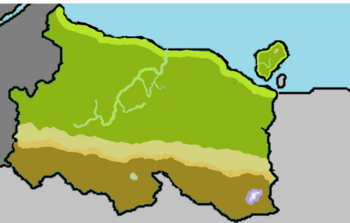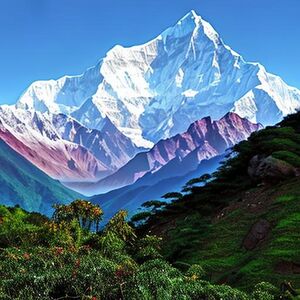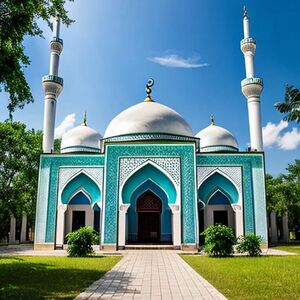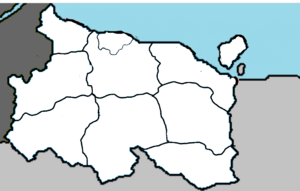Bentho: Difference between revisions
No edit summary |
No edit summary |
||
| Line 126: | Line 126: | ||
Geography in Bentho plays an important role in the development of its culture and history. The two main regions of Bentho are the [[Sarkos]] and the [[Cordillera del Illimani]]. The [[Sarkos]], located in the northern half of the country, is a warm region which recieves a lot of rain. Major cities are located inside of the tropics, such as [[Caapulas]]. Undeveloped areas of the [[Sarkos]] are highly protected by government in the form of nature reserves and national parks, which contributes both to the maintaining of Bentho's biodiversity and the tourism sector. The [[Benthenses Capybara]], the national animal, is only found in the Sarkos region. | Geography in Bentho plays an important role in the development of its culture and history. The two main regions of Bentho are the [[Sarkos]] and the [[Cordillera del Illimani]]. The [[Sarkos]], located in the northern half of the country, is a warm region which recieves a lot of rain. Major cities are located inside of the tropics, such as [[Caapulas]]. Undeveloped areas of the [[Sarkos]] are highly protected by government in the form of nature reserves and national parks, which contributes both to the maintaining of Bentho's biodiversity and the tourism sector. The [[Benthenses Capybara]], the national animal, is only found in the Sarkos region. | ||
The [[Cordillera del Illimani]] is the southern mountainous region of Bentho. The Cordillera's climate is defined by the Ausianan steppes to the south and the warm tropical ocean temperatures to the north, effectively acting as a rain shadow to much of Cirrane. The region's rainy season occurs from September to March (although it can start as late as December) and a dry, cold season exists from May–August. [[Mount Alonso]] is the highest peak in Bentho, with a height of 9,762 feet (2,975 meters). | The [[Cordillera del Illimani]] is the southern mountainous region of Bentho. The Cordillera's climate is defined by the Ausianan steppes to the south and the warm tropical ocean temperatures to the north, effectively acting as a rain shadow to much of Cirrane. The region's rainy season occurs from September to March (although it can start as late as December) and a dry, cold season exists from May–August. [[Mount Alonso]] is the highest peak in Bentho, with a height of 9,762 feet (2,975 | ||
meters). | |||
[[File:Img-DBJOtLUVyMM1BA3632l5r.jpg|thumb| Mount Alonso during winter]] | |||
==Demographics== | ==Demographics== | ||
Revision as of 07:09, 4 June 2023
Secular Republic of Bentho República Secular de Bentho | |
|---|---|
|
Flag | |
| Motto: "Bentho, Com Todos Os Caminhos e Tempo" | |
 Map of Bentho | |
 Geography of Bentho | |
| Capital and City | San Pera |
| Official languages | Benthese, Spanish |
| Ethnic groups | Sarkosian |
| Government | |
• Presdient | Juan Carlos Caballero |
| Population | |
• 2020 estimate | 11,321,987 |
| GDP (PPP) | 2020 Estimate estimate |
• Total | 315.9 Billion |
• Per capita | 27,955.75 |
| HDI | .897 very high |
| Date format | MM-DD-YY |
Bentho officially known as the Secular Republic of Bentho, is a sovereign nation located in northeast Ausiana, in the region of Carubana. It is bordered to the west by Vulkaria, to the south by Cirrane, and to the east by Jericho, with a northern coastline along the Sea of Vulkaria in the North Samson Ocean. The 2 Main Reigons of Bentho are the Sarkos tropics and the Cordillera del Illimani. Bentho has 10 States which are Districts of San Pera, Palno, Aregoyape, Barbagaba, Jacardaes, Caumáo, Floriano, Contacicaba, and Huarmos. Bentho has a population of 11.3 million, with the majority of the country's population living near the coast. Bentho is also one of the countries never colonized, this made it so Bentho did not have it resources robbed.
Bentho is a member of the Coalition of Crown Albatross.
Etymology
The origin word for Bentho comes from the native Bentheeses word "benção", which translates to "blessing". Native populations which relied heavily on the region's abundant natural resources called the region benção, and later settlements revised to word to "Bentho".
History
Pre-Historic
Bentho was first inhabited around 5,000 years ago by native populations. It is estimated that at the time of the first contact with Adulan explorers in the 16th century there were about 6,000 Native Benthenses and some Huamorian island-settlements.
13th Century
In 1205, the first ever reported source of the term "Bentho" or "Bênção", was used by Sílvio Campos Kanashiro, the the founder of San Pera. The first ever reported use of Bênção which translate to blessing in Bentheese, found in Kanashiro's book entitled Bênçãos da Terra, where he refers to Bênção as Bentho.
20th Century
The Bentheese economy began to grow with its most important sectors being in lumber, farming, and fishing, and the introduction of the Vulkarian Pass placed Bentho right on the precipice of a new vital and heavily used international shipping lane, which contributed greatly to a boom in its economy. A severe drought in 1929 led to the Bentho Depression, which not only affected the agricultural and freshwater fishing industries, but led to the deaths of tens of thousands of people. A religious reconciliation occured as a result of the depression, which was a major contributing factor in Bentho's relative secularism to this day.
World War
Bentho's government attempted to stay neutral at the outbreak of the World War in 1949, during which time the DSC and Rumaztria had invaded and conquered much of neighboring Vulkaria in order to seize vital port cities and the Vulkarian Pass. Bentho's economy, reliant on international shipping passing through the canal, took a major hit as shipping ceased and neighboring countries joined the League Powers. Bentho's government signed multiple non-hostility treaties with the DSC and Teresta to avoid being drawn into the conflict, but the government was covertly supplying weapons and food to Vulkarian resistance fighters. Bentho successfully remained out of direct conflict for around 8 months, instead becoming a haven for many refugees fleeing fighting in northeastern Ausiana.
Sometime in September 1951, a telegram directed from Bentho to resistance fighters in Vulkaria was intercepted by League Forces in Tilbreg, detailing the covert supply missions. As a result, on October 19th, 1951, Teresta and Gashuera broke their non-aggression treaties with Bentho and invaded through occupied Jericho and Cirrane. Bentho's military, small in comparison to the well-equipped and experienced league forces, was decimated in the invasion, and the country's major population centers were quickly overrun. However, many rebel groups sprung up within Bentho to resist the occupation, with vice-president Francisco Cruz Madruga in particular leading several factions. For two years, brutal urban and rural fighting engulfed Bentho as a sizable portion of the population took up arms against Terestan and Gashueran forces. The Battle of Quipata in early 1953 saw the first instance of Bentho's resistance groups freeing one of their major cities from occupying armies.
By December of 1952, the DSC had been pushed out of the northern half of Vulkaria by Allied forces, and Ruzmatrian forces were in retreat on the southern front. In July 1953, allied forces consisting of Emmirian, Albarinean, and Cadairi troops entered Bentho from the freed areas of Vulkaria and began pushing back Terestan forces. They were joined by the Bentho resistance groups, who were vital in the success of allied forces. Gashuera capitulated on August 6th, 1953, leaving Teresta a weakened and vulnerable military. By August 8th, the capital of San Pera was freed, and on August 19th the last Terestan forces retreated over the border into Jericho. Following the liberation of Bentho, Marcos Amorim Esteves sent two brigades of men to participate in the Eastern Front of the war in Euronia, where they assisted in the liberation of Avergnon.
Geography
Geography in Bentho plays an important role in the development of its culture and history. The two main regions of Bentho are the Sarkos and the Cordillera del Illimani. The Sarkos, located in the northern half of the country, is a warm region which recieves a lot of rain. Major cities are located inside of the tropics, such as Caapulas. Undeveloped areas of the Sarkos are highly protected by government in the form of nature reserves and national parks, which contributes both to the maintaining of Bentho's biodiversity and the tourism sector. The Benthenses Capybara, the national animal, is only found in the Sarkos region.
The Cordillera del Illimani is the southern mountainous region of Bentho. The Cordillera's climate is defined by the Ausianan steppes to the south and the warm tropical ocean temperatures to the north, effectively acting as a rain shadow to much of Cirrane. The region's rainy season occurs from September to March (although it can start as late as December) and a dry, cold season exists from May–August. Mount Alonso is the highest peak in Bentho, with a height of 9,762 feet (2,975 meters).
Demographics
Religion
Religion in Bentho has shifted over time. Prior to the World War, the prominent religion was Sanguine. The decline of religion in Bentho came largely as a result of the Bentho Depression in 1929 and the World War, both events which contributed to a major reevaluation of faiths in Bentheese society. In 2022, 78% of Bentho's population was non-religious.
The most followed religion in Bentho is Catholicism, with around 8% of the population (~905,000 people). Most catholic groups are located in the north of the country. The next largest religion is Shintoism, with 5% of Bentho's population practicing. Islam consists of around 3% of the population and is the fastest growing religion in Bentho. There are laws protecting Islam from hate-crimes, passed by presdient Mónica Ramos in 2003.
Bentho banned religious involvemnt in the government in the Bentho Constitution. As defined in article 7; "Any religion that has a way of overpowering the national or local government must be avoided at all costs, to protect it from biased behavior of his or her ways of life." However, someone who is religious can run for president or political office, though they can face being removed from office if it is deemed religion played a part in their policymaking.
Population
Bentho had a population around 11.3 million in 2022. The majority of the population is aged 24-29, contributing to Bentho having one of the youngest average populations in the world. It also has one of the highest literacy rates among its population, at 98.4% of people knowing how to read and write. However, Bentho has one of the slowest growing populations in the world, having not increased more than 30% since the end of the World War in 1954. Bentho's population is estimated to reach 18 million in 2050.
The majority of Bentho's population is native to Bentho, with 88% being native Bentheese, 2% Pongian, 5% Vulkarian. In 2022, the majority of foreign visitors or immigrants to Bentho spoke their native languages. The fertility rate in Bentho is 1.54 births per women. There is 993 males per 1,000 females in Bentho.
Politics
Legislature
Bentho has 3 branches of the government in the capital of San Pera. The Bentho Senate is the upper legislature, which has 100 seats (10 seats per state). The Bentho National Assembly has 500 seats. The senate votes on bills, laws, and holds the power to impeach political officeholders. The Senate, which was founded in 1604, has an election every 1.5 years. The National Assembly's purpose is largely focused on international issues, such as voting on treaties, militarily interventions, and trade deals. The National Assembly has an election every 6 years.
Foreign Relations
Bentho has several diplomatic relations with nations around the world. Most nations have their consulates or embassies in San Pera. The Ministry of Foreign Affairs, headed by the Goverment of Bentho, oversees diplomatic ties. With globalization, Bentho's links to southwest Adula in particular have strengthened. Internationally, Bentho is a strong advocate of constitutional democracy and individual liberties. Its international relations historically have been guided by the principles of nonintervention, multilateralism, respect for national sovereignty, and reliance on the rule of law to settle disputes.
Bentho's closest ally is Pongi, due to similarities within their governments, historical and cultural relations, and recent global events.
Embassies in Bentho
States
| Province | Postal abbrev. |
Capital | Population | National Asembly Seats |
|---|---|---|---|---|
| District of San Pera | DSP | San Pera | 1,493,098 | 10 |
| Palno | PAL | Lazana | 2,119,102 | 17 |
| Caumao | CUA | Monsotivo | 903,216 | 16 |
| Chiquique | CHI | Huabo | 1,236,908 | 8 |
| Aregoyape | ARE | Caapulas | 1,391,043 | 11 |
| Jacardaes | JAC | Quipata | 1,376,210 | 11 |
| Florina | FLO | Jerica | 408,554 | 9 |
| Contacicaba | CON | Yebati | 1,376,210 | 6 |
| Barbagaba | BAR | Lamlota | 983,219 | 8 |
| Huamors | HUA | Tepiapó | 1,413,637 | 12 |
Military
The main miltary of Bentho, the Benthenses Armed Forces (BAF), were created in 1859 after a failed goverment coup. Conscription is required for both men and women for at least 1 year, though some factors may alter that requirement such as sports, disability, or illness. Each member of the military has their bills paid for their family during their service. On the island of Huarmos, the Huarmos Island Forces (HIF) acts as an autonomous branch off the Benthenses Armed Forces. Nearly 250,000 of the Benthenses are currently in the miltary and around 1,000,000 reserve, thanks to conscription laws.
Bentho has few tense relations with other nations, and has not had its sovereignty threatened since the end of the World War, due in large part to its remote location. The military has three branches; the Bentho Army, Bentho Navy, and Bentho Air Force. The Bentheese Navy is a green-water navy and rarely operates outsie of the Sea of Vulkaria. The Navy has one aircraft carrier, called the NAE San Pera. The mission of the Air Force is to conduct strategic and tactical aerospace operations on behalf of the national defense, exercising the sovereignty of the Benthese airspace.
Culture
Sports
Sports in Bentho are a major part of its national identity and culture. The most popular sports are soccer, rugby, and baseball. Bentho Primera División is the biggest soccer leauge in Bentho, with Bentho Leauge 2, Bentho Leauge 3 Bentho Leauge 4 being lower leauges. The Bentho national football team represents Bentho in international tournaments like the World Cup and the Olympics.
Rugby is the second-most popular sport in Bentho. The Caapulas Capybaras placing runners-up in the International Rugby League's 2023 championship, falling short to the Tarijibar Lions.
Art
Bentho's art scene is largely centered around painting. Benthos most famous painter, Iker Gutierrez, is well known for utilizing the natural landscapes of Bentho in his imagery, renowned often for choosing a seemingly random place in Bentho to paint. His most famous works include the O Meditação (the Meditation). Gutierrez, born in 1939, still produces art which he donates to the Arte do Bentho, the museum he frequented as a child.
Cuisine
Benthenses Cuisine is another important staple of the national culture. Depending on the area of the country, the food varies. The north of Bentho, with cities like San Pera, food tends to have more vegetables and flour. Wheat in Bentho is rare to find in culinary products, as rice, buckwheat, and tapioca is the main source of flour in Bentho. North Bentho Cuisine tends to have more products that are sweet and sour, thanks to its tropical climate. Bentho is the world's largest exporter of mangoes, and cooking with mangoes is quite common throughout the north of the country. In the southern mountainous regions, cuisine tends to be less diverse and less flavorful than the north.
Economy
Bentho's economy has a socialistic and capitalist aspect to it, private industry is allowed but to get a business it must be approved by the goverment first. The business that the owner creates is owned and ran by the person who made it, but the government is the overseer-er and if the business does violates the contract it agreed to, it will be seized and handed over to the government. The auron is worth around Z$1.19
Bentho's economy is heavily dependable on the tourism industry, tourism makes up around 300 billion aurons of Bentho's economy, and adds around 500 Million- 1 Billion each year , Bentho allows tourist to work in Bentho without a VISA for a limited time, this is called a work-away, this produces money for the economy and allows tourist who are short on money to make some.
Trade
Bentho's biggest trading partner is Zamastan, Bentho recives the most imporants from Zamastan. Seconded to that is Vulkaria which Bentho trades the most receiving the most imports that are received in Bentho, there is no documented embargoes that Bentho has placed on others or has received from other countries. Bentho's exports the most mangoes in Iearth around $30.5B of Bentho's economy is mango backed and adds around 126.5M to the economy each year.













